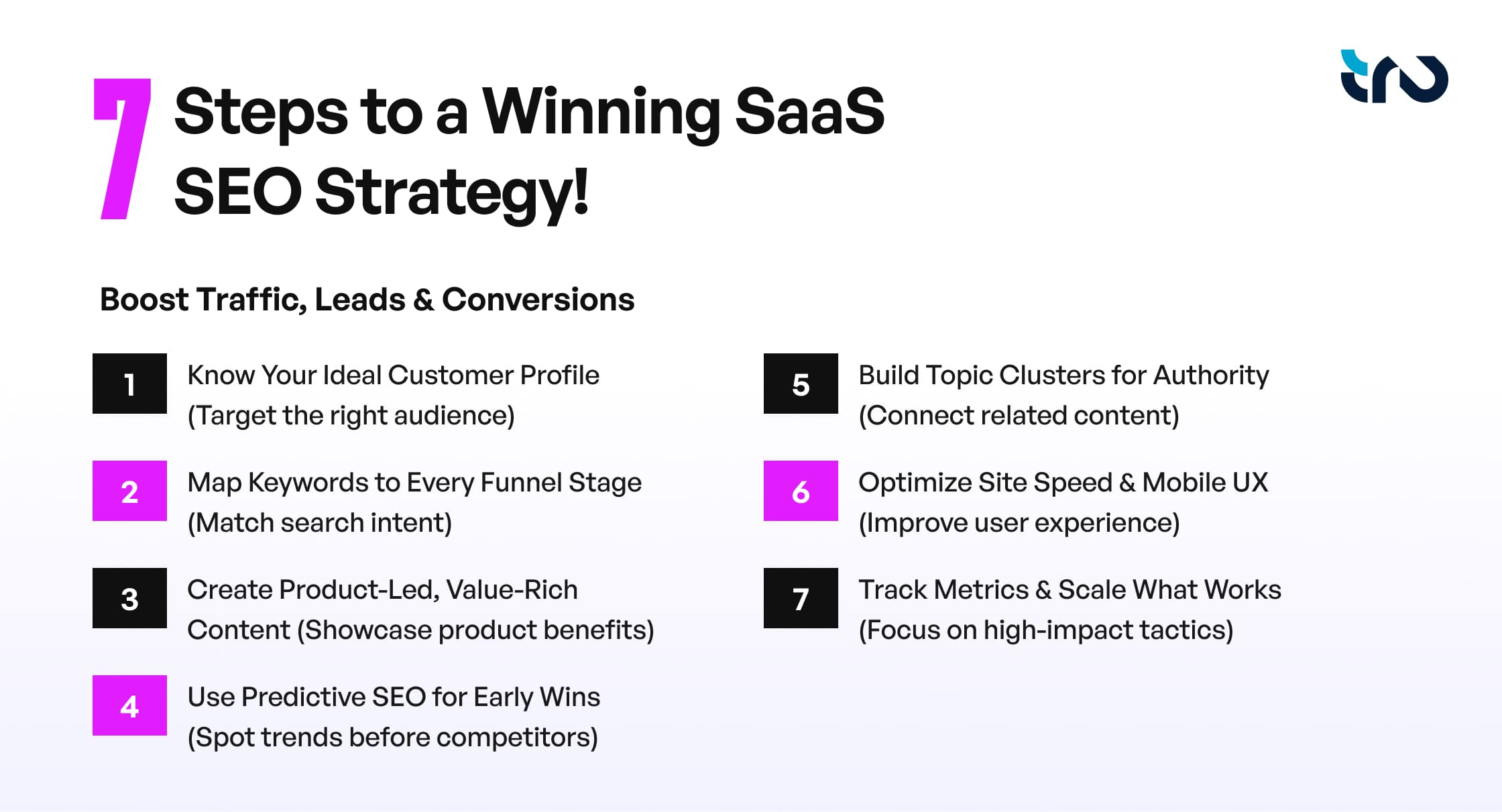Ever thought of what kind of ROI SEO can really deliver?
A report by FirstPageSage on SEO ROI statistics claimed, "A B2B SaaS company saw a 702% return on SEO investment, reaching breakeven in just 7 months".
To simplify, if they invested $10,000 in SEO, they earned $70,200 in revenue attributable to that SEO investment. This wasn’t just a win but a clear case for prioritizing organic traffic in your SaaS growth plan.
When it comes to SEO, most SaaS companies often face challenges like long sales cycles, niche markets, and high Customer Acquisition Cost (CAC). These factors are what make the SaaS SEO strategy quite different from traditional SEO approaches.
In this guide, we will discuss what SaaS for SEO involves, why it’s crucial, and how to create a strategy that drives real growth. We’ll also highlight common mistakes and a list of useful tools that can help boost the SaaS SEO.
What is SEO for SaaS
SEO for SaaS refers to addressing specific challenges of the SaaS website and optimizing it to enhance its visibility on search engine platforms like Google.
When your SaaS business ranks at the top for different search queries, it naturally brings organic traffic, including potential customers. This generates high-quality leads without heavy spending on ad campaigns, and also improves your brand value.
A SaaS SEO funnel guides users from discovery to decision using targeted content at each stage. It aligns search intent with your product’s value, turning traffic into trials and trials into loyal users.
TOFU (Top of Funnel) attracts with broad educational content, MOFU (Middle of Funnel) nurtures with use cases and comparisons, and BOFU (Bottom of Funnel) converts with product pages and demos.

Why SEO Matters for SaaS Companies
While ad spends eat most of the marketing budgets, SEO for SaaS becomes a long-term growth engine. Here’s what SaaS SEO offers:
Sustainable ROI: Unlike paid ads that stop performing once the budget dries up, SEO content keeps generating traffic and leads over time.
Lower Customer Acquisition Cost (CAC): Organic search reduces reliance on expensive paid channels, helping you acquire users more efficiently.
Trust & Credibility: Ranking high for relevant queries builds authority and positions your SaaS as a go-to solution.
Supports Long Sales Cycles: SEO-driven content helps educate and nurture leads throughout the buyer journey, from awareness to conversion.
Improved Scalability: As your SaaS product evolves, your SEO content can too. Easily support new features, use cases, and customer segments with SEO.
SaaS SEO vs. Traditional SEO
The traditional concept of SEO has the eventual goal of quick traffic wins and sales. It mostly relies on high-volume keywords, standalone content (like listicles), and shorter funnels with less emphasis on engagement. SaaS SEO, on the other hand, uses nurturing leads to support longer funnels and sales cycles. It focuses on problem-solving, education-based, and intent-driven keywords to optimize the user’s journey through each touchpoint.
While both aim to drive visibility, SaaS SEO is more strategic, conversion-focused, and tailored to a recurring revenue model.
Below is the simplified tabular difference between SaaS SEO and Traditional SEO:
Aspect | SaaS SEO | Traditional SEO |
Goal & Sales Cycle | Generate qualified leads with a longer, education-driven cycle | Drive quick sales or traffic with a short cycle |
Content Strategy | Product-focused, value-rich, targeting intent-based keywords at all funnel stages | Feature/promotional content targeting broad, high-volume keywords |
Content Structure | Topic clusters with related content | Mostly standalone pages and blogs |
Funnels | Full-funnel strategy: TOFU (blogs, guides) → MOFU (case studies, comparisons) → BOFU (product pages, demos) | Majorly TOFU-focused: drive traffic to top pages, with fewer deeper funnel assets |
Conversion Focus | Track trials, demos, sign-ups, engagement | Track sales, leads, and direct conversions |
Optimization Focus | UX, technical SEO, and nurturing | Ranking, backlinks, and traffic volume |
The Best SaaS SEO Strategy
A winning SaaS SEO strategy is not only about traffic. It also includes attracting qualified users, aligning content with product value, and scaling growth predictably.

1. Map Search Intent to Your ICP
Don’t just use popular keywords; map high-intent queries to each stage of your Ideal Customer Profile’s (ICP) journey. Think about what your ideal customer is searching for at each stage and create content for each step.
Consider these examples:
Early Stage: “What is project management software?” → Write a beginner's guide.
Middle Stage: “Best tools for remote teams” → Create a listicle-style blog.
Final Stage: “[Your tool] vs [Competitor]” → Build a detailed comparison page with a demo link.
2. Build Product-Led, Value-Rich Content
Create content that educates while subtly showcasing your product. Think interactive demos, integration guides, and use-case blogs where value and product naturally intersect.
3. Use Predictive SEO to Get Ahead
Analyze market trends, emerging questions, and rising keywords before they peak using tools like Exploding Topics, Google Trends, and AI forecasting. Rank before your competitors even show up.
4. Scale with Programmatic SEO
Build thousands of useful, indexable pages at scale (e.g., templates, use cases, location-based pages) using structured data and automation without sacrificing quality or UX.
5. Own Topics with Semantic Clusters
Go beyond keywords. Build authority through tightly connected content clusters using NLP tools like Clearscope or Frase to cover semantic variations and topical depth.
6. Optimize for UX-Driven Conversions
Every blog, guide, and page should function like a landing page. Clear CTAs, fast load times, responsive design, and subtle nudges (chatbots, scroll triggers) move users toward action.
7. Analyze What Converts, Then Automate
Tie your content to actual product metrics—sign-ups, demo requests, activation. Use CRM + analytics data to identify what works, then automate what’s repeatable.
Ready to turn your SEO into a scalable growth engine? Partner with Tru for the best global Digital Marketing Services that drive real, measurable results.
Common SEO Mistakes SaaS Companies Make
Even the smartest SaaS brands stumble on SEO. Here are the most common pitfalls and how to avoid them.
1. Keyword Stuffing Instead of Strategic Targeting
Search engines quickly recognize low-value, keyword-heavy pages and penalize them. So you must focus on creating helpful content that naturally includes well-researched keywords, prioritizing user experience, and search intent.
2. Neglecting Mobile-First Optimization
Ignoring mobile optimizations can cost you the maximum of potential traffic and engagement. Thus, optimizing mobile SEO by using a mobile-responsive design, compressed images, larger fonts, simple navigation, and proper QA is important.
3. Missing Out on Social Signals & Visibility
Social media is an overlooked SEO ally that is not directly linked with rankings. But when your website’s content is engaging, has bold headlines, and eye-catching visuals, it amplifies your content’s reach through audience interaction.
4. Ignoring Local SEO for Office & Regional Presence
If your SaaS has a regional presence or office, ignoring local SEO means missing location-based searches. Optimize your Google Business Profile, use location-specific keywords, and keep NAP (Name, Address, Phone Number) info consistent across directories.
At Tru, we decode the blind spots most SaaS companies overlook. We replace keyword noise with precision strategy, embed mobile logic into every experience, and turn social signals into search momentum. Our SEO and Organic Services are built not to follow SEO trends, but to shape them.
Tools to Help With SaaS SEO
The right tools can make SaaS SEO more strategic and efficient for business enterprises. Here’s a quick list by category:
1. Keyword Research & Competitive Analysis
Ahrefs – Explore keywords, backlinks, and competitor content.
SEMrush – Track keyword rankings, audit sites, and monitor competition.
Ubersuggest – Budget-friendly tool for keyword ideas and traffic estimates.
2. Technical SEO & Site Auditing
Screaming Frog – Crawl your site to fix broken links, redirects, and metadata.
Sitebulb – Visual technical audits with actionable insights.
Google Search Console – Track indexing, site health, and performance metrics.
3. Content Optimization & Planning
Surfer SEO – Optimize content for SEO based on real-time SERP data.
Clearscope – Improve readability and relevance for target keywords.
Frase – AI-powered tool for content briefs and question-based content planning.
Final Thoughts
SEO today is not limited to just getting clicks. Instead, it is now used to attract the right audience and create user-centric journeys. It guides potential customers through longer decision-making focused on conversion at every touchpoint.
By embracing full-funnel content, predictive SEO, and product-led strategies, SEO gives a blueprint to a SaaS company’s most powerful growth engine.
Turn Traffic Into Trials, Demos & Deals - Partner with Tru
Contact UsFrequently Asked Questions (FAQs)
SaaS SEO is the process of optimizing a Software-as-a-Service website to rank higher on search engines, attract qualified traffic, and convert users. This is done while overcoming challenges like long sales cycles, niche markets, and high CAC without relying heavily on paid ads.
SEO is crucial for SaaS because it lowers customer acquisition cost, supports long sales cycles with informative content, builds brand trust, and drives long-term, organic growth. It’s a scalable way to generate leads and trials at every stage of the funnel.
Here are the steps to build a conversion-focused SaaS SEO strategy:
- Know Your ICP to align with real search behavior
- Match Keywords to the Funnel to hit intent at every stage
- Publish Product-Led Content to blend value with conversion
- Speed Up & Simplify UX to boost mobile engagement
- Cluster Content Smartly to build topical authority
- Track What Works to double down on top performers
The best B2B SaaS SEO strategy combines predictive SEO to identify rising trends early. It pairs this with a product-led, full-funnel content plan that guides prospects from awareness to conversion. This approach ensures your traffic not only comes but also converts effectively.
To find SaaS SEO keywords, research your audience’s pain points and use tools like Ahrefs or SEMrush to discover intent-driven terms across the funnel. Combine broad topics with specific product phrases that fit your Ideal Customer Profile.



